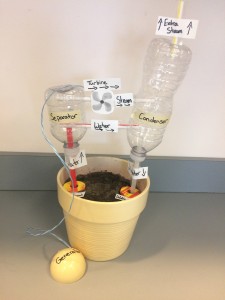Our project:
Execute: Our group completed a project, by answering the questions given to us as well as creating a 3D Model of a geothermal power plant out of a variety of different materials found around our homes.
Examine: We completed the project on time, fully meeting all of our goals. We now have a better understanding of how a geothermal power plant works and the effects that they has on the environment as well as the social and ethnical implications that they have. If we had been given more time to work on the project we think that we could have created an even bigger an better model. We could have possibly made it move or even make water flow through it.
How things work Questions
1. The geothermal vent is the first component of any geothermal plant. A geothermal vent is a deep well drilled into the Earth that the power plant uses to tap into the Earth’s heat. A geothermal plant may have two goals for its vents, geothermal plants draw superheated, pressurized water upward.
Another important part of any geothermal plant is the steam production unit, which can take multiple forms. In a flash steam vent, heated pressurized water is drawn from underground and goes into low-pressure tanks. The pressure of the Earth keeps the water in liquid form and by removing that pressure the hot water instantly turns to steam. In a dry steam plant, the plant technicians pump water to the bottom of the vent where the Earth’s heat boils the water and turns it into steam. The steam then goes to the turbines.
It doesn’t matter which of the plant types, both flash steam and dry steam plants pump the steam from the geothermal vent to a large turbine. The steam passes this turbine, turning it in the process. This turbine is attached to an electric generator, and as the turbine turns the generator turns the mechanical energy into electric energy, this converts the heat from the Earth into usable electricity.
After the steam passes through the turbine, it continues to a condenser chamber. This chamber condenses the steam back into water by cooling it. The extra heat lost as the steam turns to liquid may be used for other things, such as heating or greenhouse farming. The cold water is then typically pumped back into the ground to either restart the boiling process for dry steam or to restock the natural heated aquifer for flash steam plants. A properly located well can be a good energy source for many years. Electrons flow from underground up the well, into the separator and then go through the turbine and move into the generator.
2. Most geothermal plants re-inject water into the reservoir after it has been used to prevent contamination. In most cases, not all water removed from the reservoir is re-injected because some is lost when it turns into steam. In order to keep a constant amount of water in the reservoir, outside water must be used. The amount of water needed depends on the size of the plant and the technology that it uses. This could have an effect on country’s that don’t have access to a lot of water and it would be difficult to build a power plant without the water needed.
The amount of land required by a geothermal plant varies depending on the how big the reservoir is. Some of this land could be used for other things like building homes or shelters in countries that need it. Overall we think that geothermal power plants are a great way to create energy and electricity efficiently and in a way that will protect the environment.
3. Geothermal power plants have many positive and negative effects. We think that geothermal power plants are a good idea since there are so many positive aspects for the environment and social implications. There are however a few problems with how much water is used for geothermal power plants, which is a problem since our world is running low on water. We think that geothermal power plants are the safest and most environmentally friendly way to create energy. Because there is very little air emissions and it is a renewable energy source unlike fossil fuels. Geothermal power plants have very low impact on the environment and very few social implications. They are a better option when creating energy as opposed to ex: fossil fuels (since they aren’t renewable).
4. Geothermal power plants have some positive and negative effects on the environment. A positive is that they take up very little land and installing one does not require damming rivers or cutting down forests and there are no mineshafts, open pits, oil spills or tunnels. Geothermal is classified under clean and renewable resource, unlike fossil fuels that we will run out of at some point. Another good point about geothermal power plants is that they have minimal solid wastes. Geothermal power plants give of less gases in the air unlike a thermal power plant that does. Thermal power plants give off CO², SO² and nitrogen oxides, geothermal power plants only give off a little CO² and SO² and absolutely no nitrogen oxide. One of the negative aspects of geothermal power plants is that they will be very loud due to heavy earth moving machinery during construction, well testing, cooling tower complex, gas ejectors and the main powerhouse. Geothermal power plants also waste a lot of water which is a big problem, however the way the water is disposed is not considered toxic. Since so much water is being used the earths elements may become different shapes due to lack of water. Vegetation and soil may also be affected when a geothermal power plant is installed or being used. Something called well blowout may also happen which means there would be an escape of fluids from a drilling well when there is high pressure.
Parteners: Shaylyn Gordon and Hannah Stark
